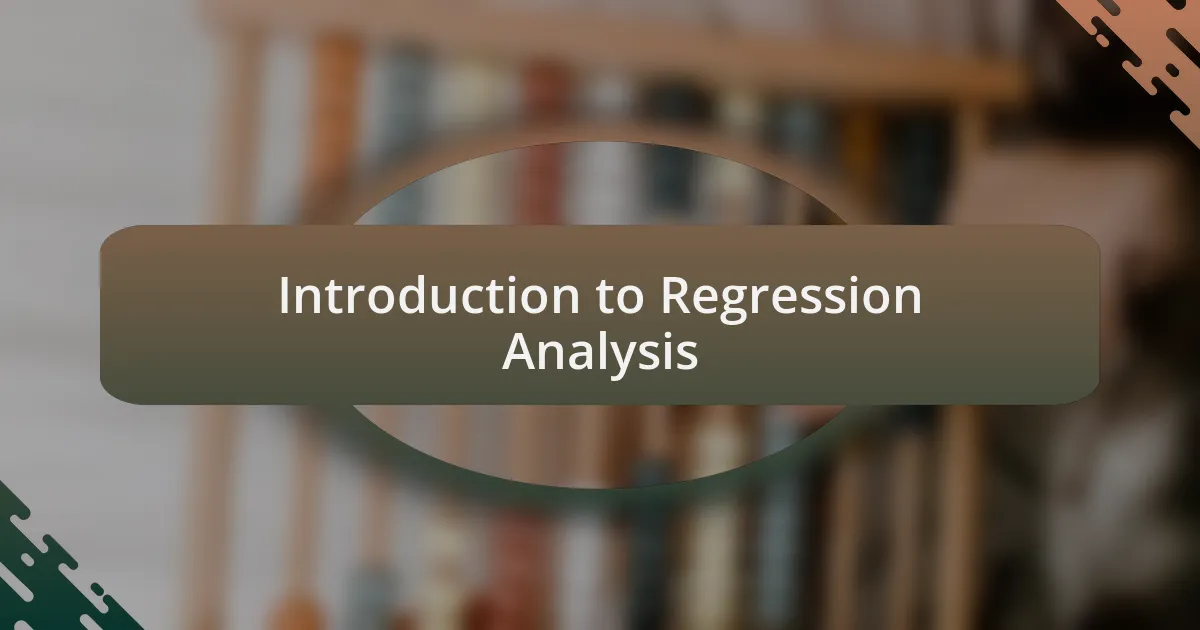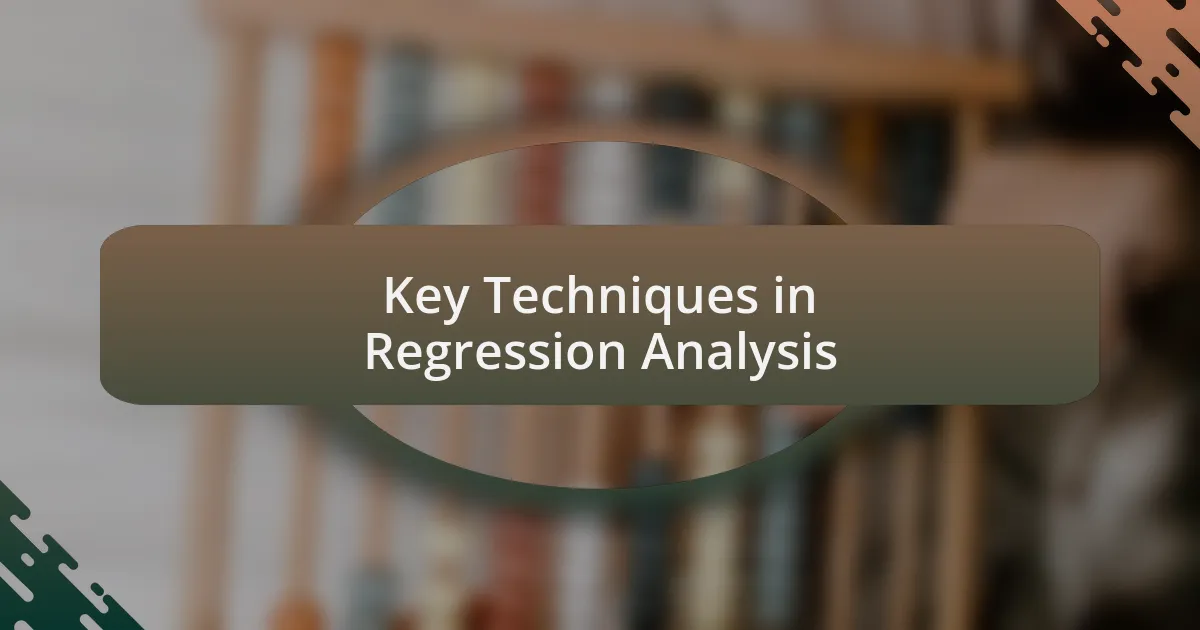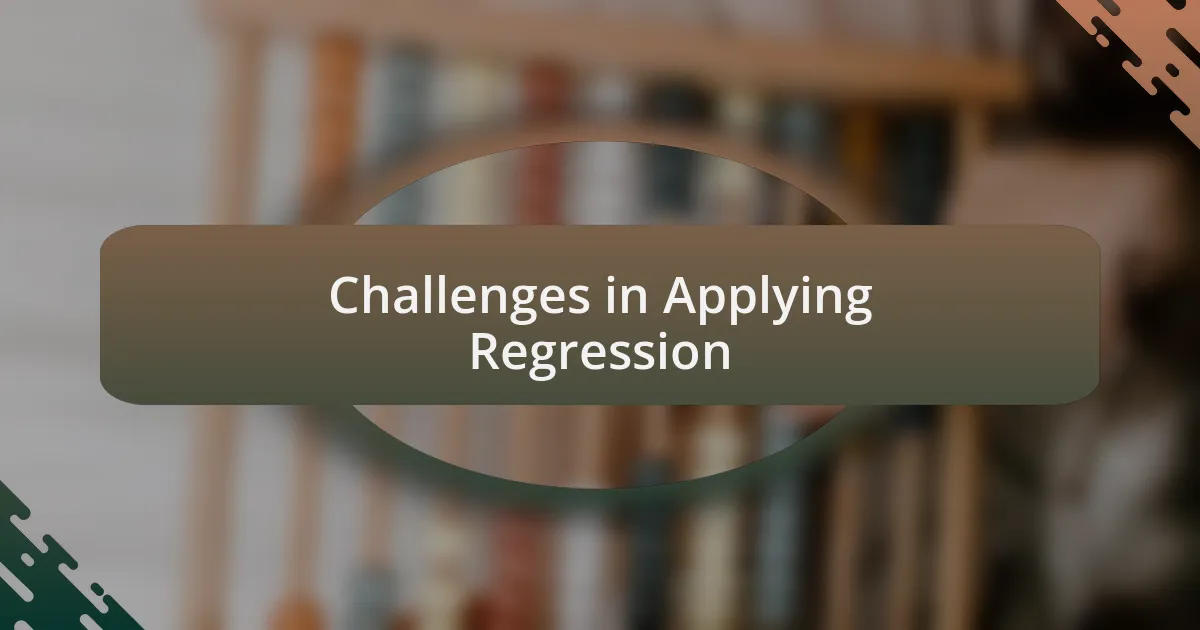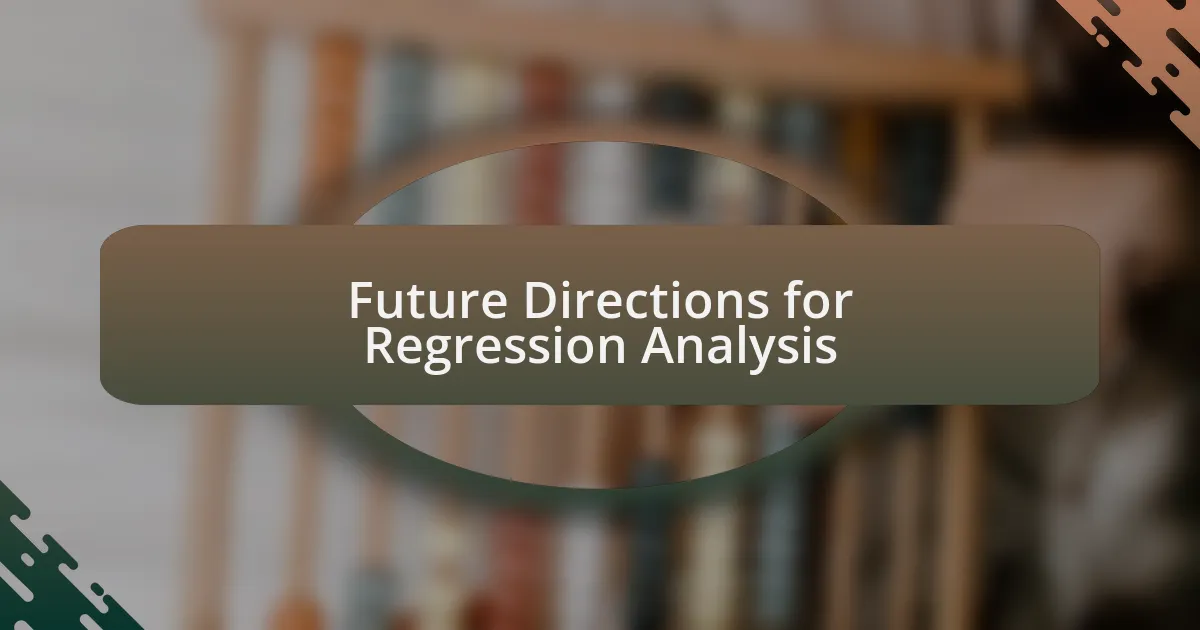Key takeaways:
- Regression analysis reveals relationships between variables across various fields, aiding in making informed decisions and uncovering insights.
- Key techniques include model selection, variable selection, and regularization methods, which help address challenges like outliers and multicollinearity.
- The future of regression analysis lies in personalized medicine, understanding ecological impacts of climate change, and influencing policy-making through data-driven insights.

Introduction to Regression Analysis
Regression analysis is like a detective’s toolkit for uncovering relationships within data. I remember the first time I applied it to my research; I was almost giddy as I watched how the behavior of one variable could explain changes in another. It felt like peeling back the layers of an onion, revealing deeper insights hidden beneath the surface.
What strikes me about regression analysis is its versatility—it can be applied across various fields, from biology to economics. Have you ever wondered how researchers predict outcomes using data? By utilizing regression, they can model the relationships between variables, which helps in making informed decisions. This analytical method transforms raw data into actionable knowledge, and I’ve seen firsthand how it can drive breakthroughs in scientific exploration.
When I first grasped the concept of linear regression—finding the best-fitting line through a scatterplot—it was a bit overwhelming. Yet, with practice, I came to appreciate its elegance in simplifying complex data sets. It almost feels like a conversation with the data, where each point shares a story and every trend unveils a narrative waiting to be explored. Don’t you find it fascinating how much we can learn from simply observing patterns?

Importance in Mathematical Biology
Understanding the importance of regression analysis in mathematical biology is truly enlightening. I recall a project where I used it to analyze population growth trends in species. Seeing how environmental factors interacted with population dynamics right before my eyes was a game-changer—it sparked my curiosity about the intricate balance of ecosystems.
Regression analysis helps unravel complex biological processes, identifying key factors that influence organism behavior and health. For instance, when studying the effects of a newly introduced variable on a species’ survival rates, regression models provided me with clarity I didn’t anticipate. I still remember the moment I realized that a single coefficient could represent a significant change in the population’s future; it was like finding the missing puzzle piece in a vast landscape.
Moreover, this analytical tool allows researchers to make predictions that can shape conservation strategies and medical interventions. I often wonder: how different would our approach to species conservation be if we had precise models to guide us? The potential impact of regression analysis in predicting disease outbreaks or assessing the success of treatment methods feeling almost limitless—a thought that leaves me both inspired and hopeful for future discoveries.

Key Techniques in Regression Analysis
When diving into regression analysis, one of the fundamental techniques that stands out is the selection of the right model type. I recall a time when I wrestled with choosing between linear and nonlinear models for my research on enzyme activity rates. The decision felt monumental, but understanding the underlying biology helped clarify the best fit. This experience taught me that matching the model to the biological question is vital; it can dramatically influence the results and their practical implications.
Another key technique is variable selection, which I found crucial while assessing the impact of multiple environmental stressors on plant growth. I remember sifting through a multitude of potential variables, grappling with which ones to include in my analysis. This process highlighted the importance of discerning which factors genuinely affect outcomes, ensuring that my conclusions were not just statistically significant but biologically meaningful. Have you ever faced a similar challenge? If so, you know how important it is to sift through the noise to find clarity.
Lastly, the power of regularization methods, like Lasso and Ridge regression, cannot be overstated. I encountered these techniques during a project where I was overwhelmed by multicollinearity—where predictor variables were highly correlated. Implementing regularization strategies allowed me to simplify my model while maintaining predictive accuracy. It’s fascinating how these methods can act as a safety net, helping researchers like me navigate the complexities of real-world data, ensuring we don’t lose sight of the biological story amidst the numbers.

Challenges in Applying Regression
One of the biggest challenges I’ve faced in applying regression analysis is dealing with outliers. There was a project I worked on involving species population data, and a few extreme values skewed the results. The emotional rollercoaster of debating whether to include or exclude these data points was intense. I found myself asking, “What do these outliers really tell us?” In the end, my decision hinged on understanding their biological relevance, rather than just their statistical impact.
Another significant hurdle is the assumption of linearity. During my studies on growth rates of bacteria, I initially assumed a straightforward linear relationship between nutrient concentration and growth. I was stunned when I realized the relationship was actually nonlinear. It caught me off guard, but it reinforced a crucial lesson: biological systems often defy simple mathematical conventions. Have you ever felt that surprise when your data challenges your initial assumptions? It’s a reminder that our biological questions can guide our analytical approach.
Finally, multicollinearity frequently complicates regression analyses. In one study on environmental factors affecting fish reproduction, I was confronted by highly correlated predictors — temperature and dissolved oxygen were intertwined in ways I hadn’t anticipated. The frustration of trying to make sense of it felt overwhelming at times. I learned that sometimes you must strip things down to understand the bigger picture. By focusing on the strongest variables, I uncovered clearer insights, reminding me how vital it is to remain flexible in our approaches.

Real World Applications in Research
Applying regression analysis in research has been eye-opening for me, especially in ecological studies. For instance, I remember a project where I analyzed how various factors affected plant growth. By employing regression, I was able to quantify relationships and identify significant predictors, making my findings not just intuitive but backed by data. It dawned on me how powerful it can be to transform raw observations into actionable insights.
In another instance, while investigating the spread of a disease among animal populations, regression techniques helped me understand the impact of multiple variables simultaneously. It was fascinating to see how adjustments in one factor, say population density, could lead to noticeable shifts in disease transmission patterns. Have you ever had that moment when numbers reveal a narrative you hadn’t anticipated? This particular analysis deeply highlighted the interconnectedness of biological systems.
Moreover, the implications of regression extend beyond academia; they echo in conservation efforts, where I once collaborated with a team to predict endangered species’ survival rates. Each coefficient in our regression model represented a call to action. I felt a profound responsibility as I realized that my analytical choices could directly influence conservation strategies. It made me ponder, how often do we let data shape our decisions for the greater good?

Future Directions for Regression Analysis
As I consider the future directions for regression analysis, I can’t help but feel a sense of excitement about its evolving role in personalized medicine. Imagine a world where we can tailor treatment plans based on individual genomic data. I recall attending a seminar where experts discussed integrating regression models with machine learning to predict patient outcomes. The sheer potential of such advancements left me wondering—how much more effective could our health strategies become if we harness this synergy?
I also envision the application of regression analysis in unraveling complex ecological interactions under climate change. During a recent workshop, we explored how nonlinear regression could model unexpected relationships in ecosystems. This approach struck me as essential since it goes beyond linear relationships and allows for the nuances of biological complexity. It made me think—what if these models could lead us to smarter conservation practices?
Furthermore, regression analysis is set to play a pivotal role in policy-making, especially as many sectors grapple with the consequences of human activity. I often reflect on my experiences presenting data-driven insights to decision-makers. It became clear to me that using regression analysis to advocate for sustainable practices can be a powerful tool. How often do we consider the weight of our findings in shaping future policies? By merging data with effective communication strategies, I believe we’re on the brink of initiating transformative changes in society.